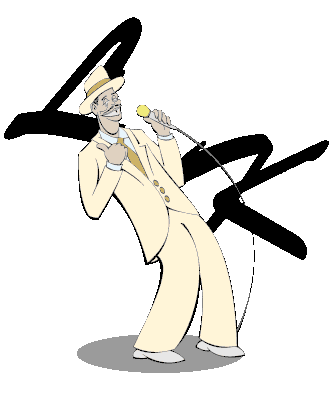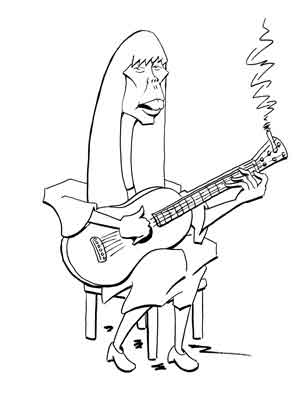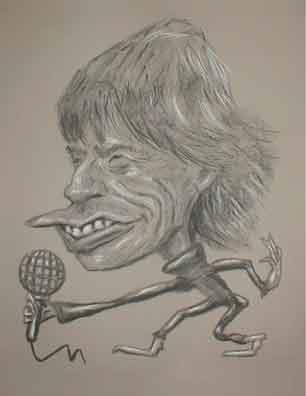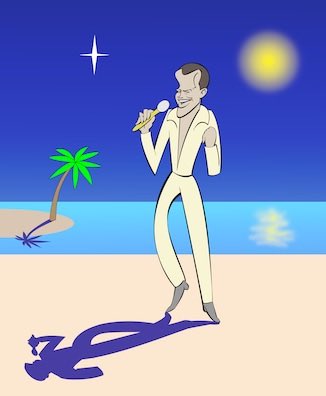Lord Kitchener
The Best of the Best

(Click to zoom in and out.)
If you were looking for information about Lord Kitchener, that is, Horatio Herbert Kitchener, 1st Earl of Kitchener, the British soldier and governor of British colonies in Africa and of India during the Victorian and Edwardian Era, all we can say is soddy, old chaps. This ain't him.
But if you were wondering about Lord Kitchener, the calypso singer, that is, Mr. Aldwyn Roberts, then this is the gentleman. And the consensus of many scholars and fans alike is that if you want to choose the King of Calypso who reigned from the mid 20th century up to the Millennium, that was the man his friends called Kitch.
Kitch is not what North Americans have come to picture in calypso singers. Instead of sporting frilled-sleeve colorful shirts, wide straw hats, and loose baggy trousers, Kitch was always impeccably dressed in suit, tie, and fedora. And far from being backed only with guitar and steel drums, he would often be joined by a full band complete with an extensive wind section.
Calypso, at least in the US, has long been linked to the songs of Harry Belafonte. But as good as Harry is, anyone who is a fan of popular music knows you can't define a whole genre by the works of a single artist. After all, what's the better representation of Rock and Roll, Joni Mitchell's "Both Sides Now" or the Rolling Stones' "Get Off of My Cloud".

Joni ...

... and Mick
Compare the two.
And indeed, the idea of calypso as the pleasant, cheerful music from Jamaica is largely a product of Harry's clear voice and his careful selection of his tunes. That calypso music can be controversial and sharply barbed becomes more evident if you delve down into the oeuvres of the indigenous singers from Trinidad.
Yes, from Trinidad. Although you can hear calypso in Jamaica (and everywhere else for that matter), scholarship traces its origins back to what is now the Republic of Trinidad and Tobago.

Harry Belafonte
(Click to zoom in and out.)
This doesn't mean that the lyrics of Trinidadian calypso are objectionable or mean spirited. When the pioneers of the music began recording - and they issued a prodigious number of discs - double entendres became the norm. This was, after all, a time when you really couldn't say on the radio the six words you can't say on the radio.
But the social commentary was there, although it could be quite watered downed when exported for the more delicate audiences. Consider, for instance, this verse from an American adaptation of a popular calypso song from World War II. The listeners in the US heard:
If you ever go down Trinidad,
They make you feel so very glad.
Calypso sing and make up rhyme.
Guarantee you one real good fine time.
And an earlier Trinidadian version?
When the Yankees first went to Trinidad,
Some of the ladies were more than glad.
They say that the Yankees treat them nice,
And they give them a better price.
Of course, the singer must have been talking about selling mangos to the hungry GI's.
Of course.
But Kitch was never a contrarian for its own sake. His hit tune "London Is the Place for Me" could almost serve as the city's official anthem. In 1969 he even wrote a song celebrating Neil Armstrong being the first man to walk on the Moon.
But if calypso runs the gamut of Harry Belafonte's "Banana Boat Song" to Kitch's "My Pussin", where did it actually begin?
Calypso as a musical genre was first mentioned in print in 1903, specifically referring to songs heard during the Caribbean Carnivals. We've seen these celebratory events where the people parade along the streets and the women are dressed in the intricate and complex (and at times massive) feathered costumes. The Carnivals (a word which is almost always capitalized) are far more elaborate than their North American namesakes which are generally limited to putting up game and refreshment stalls maybe for a week a couple of times a year. In the Caribbean, though, there is hardly a time without some Carnival celebrations.
Although calypso as a name is documented from 1903, scholars put the defining date as 1898. The music itself had two basic divisions based on whether the songs were performed indoors or out. The outdoor variety - sung by strolling musicians and singers - could be rather raucous and the topics a bit more spicy. Indoor performers tended to mute things down.
Calypso singers often assume a stage name and they can be quite imaginative. We not only have Lord Kitchener, but also Myler the Dentist, One Man Bisco, The Senior Inventor, Executor, Lion, Growling Tiger, and Atilla. There doesn't seem to be any rule what makes a good calypsonian. Some, like Kitch, grew up in a poor family and the music was a way out of their poverty. But then a number of the early songs were written by Reynold Wilkinson - a government clerk.
The lead singer in the group is called the chantwell. A good chantwell takes pride in being able to make up lyrics to fit the circumstances. When Sandy Gamory and his calypso group appeared on What's My Line he sang a clever song about the host, John Daly, and the panel members.
Traditionally calypso musicians were almost all male. But now, of course, the guys have to make room for the ladies like Singing Sandra, Lady Africa, and, of course, Calypso Rose.
References
Calypso: Early Carnival Music in Trinidad, Donald Hill, University of Florida Press, 1993.
"Discography: Lord Kitchener", Discogs.
"The Rise of Calypso Feminism: Gender and Musical Politics in the Calypso", Cynthia Mahabir, Popular Music, Vol. 20, No. 3, Cambridge University Press, October 2001, pp. 409-430.
"The Rise of Calypso Women", Dizzanne Billy, Words in the Bucket, October 10, 2016.